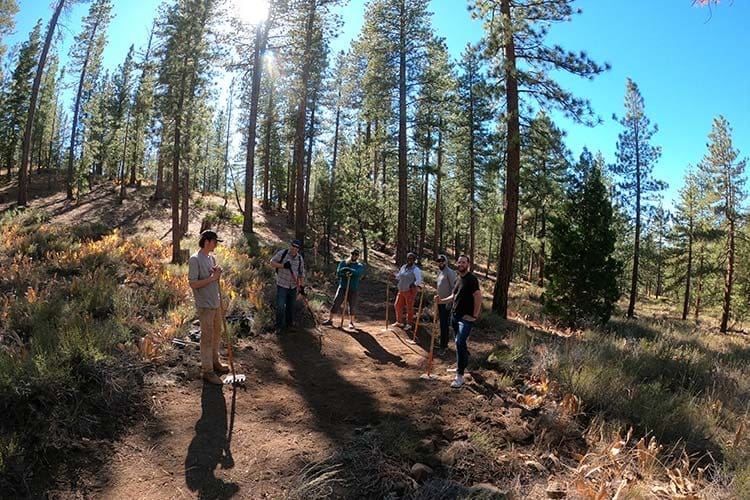Legacy Trails Program Awards Benefit 11 Mountain Bike Trail Projects
Local trail groups receive federal funding for trail maintenance to improve watershed health on public lands
The Legacy Trails Grant Program, in its second year, awarded another $1.35 million to 27 projects aimed at restoring, protecting, and maintaining watersheds on National Forest lands. Eleven of the recipients are projects benefiting mountain biking trails. These mountain biking projects received a total of $698,505 in funding from the program which local organizations have prepared to match through additional fundraising.
Promoting Sustainable Trails for Environmental Conservation
Mountain biking is an environmentally low-impact activity that aids in protecting and enjoying open space, and IMBA promotes sustainable trails to minimize impacts on the environment, natural resources, and wildlife. The 11 projects are expected to eliminate almost 100 miles of deferred maintenance on trails, provide 103 miles of trail construction and improvement, and convert almost 17 miles of unsustainable roads to sustainable trails. Through the help of at least 1,100 volunteers who will dedicate an estimated 14,765 volunteer hours to trails, the projects will build and repair 14 bridges and 23 culverts, and positively impact more than 34 species of watershed plants and animals.
David Wiens, Executive Director of IMBA, Remarks
“The Legacy Trails Grant Program continues to empower trail groups including mountain bikers to aid in conservation through regular, committed care for sustainable trails,” said David Wiens, International Mountain Bicycling Association (IMBA) Executive Director. “These projects represent diverse recreation user groups, and the power of trails in protecting and preserving outdoor landscapes across the country.”
2024 Grant Recipients Benefiting Mountain Biking Trails
Summaries are below for this year’s 11 awarded projects that benefit mountain biking in Arizona, California, Colorado, Idaho, New Mexico, North Carolina, Utah, and West Virginia.
The Legacy Trails Grant Program is made possible through the Bipartisan Infrastructure Law providing up to $1.5M per year for five years to support projects that restore, protect, and maintain watersheds on our national forests and grasslands. In the first two years, $2.7 million dollars was awarded to 65 projects across the country which will have a positive impact on watershed health, public access to the outdoors, and overall trail resiliency. This grant program is administered by American Trails and funded through a cost-share agreement with the United States Forest Service (USFS) to support trails projects on forests and grasslands managed by the USFS through 2027.
American Trails is the lead manager for this program, working collaboratively with IMBA and other trail groups to review and select projects that will provide an overall benefit to the National Forest System lands and trails network. Collaborating groups on the application review team include the American Hiking Society, the American Motorcyclist Association, the National Off-Highway Vehicle Conservation Council, Trout Unlimited, Tread Lightly, the Washington Trails Association, The CorpsNetwork, UP! Outside, the Back Country Horsemen of America, and the National Wilderness Stewardship Alliance.
IMBA encourages IMBA Local Member Organizations and other trails organizations to review the program and consider potential project eligibility prior to the 2025 application cycle.
2024 Grant Recipients Benefiting Mountain Biking Trails
Tonto National Forest, Arizona
Partners: Wild Arizona, Rim Country Mountain Bike Association, and the National Forest Foundation
Project: This project will restore the final 14 miles of the 53-mile National Recreation Highline Trail. The goals of this project are to prevent erosion and improve watershed health while increasing user safety and creating a more sustainable trail. The Wild Arizona Field Crew and partners will complete 11 reroutes, trail rehabilitation and maintenance.
Trails: National Recreation Highlight Trail #31
Santa Fe National Forest, New Mexico
Partners: Santa Fe Fat Tire Society
Project: Phase 2 of the Arroyo Hondo project aims to expand the existing trail network by 25.6 miles, redesigning and rerouting existing closed roads (12 miles) and user-created trails (7.1 miles), ensuring their sustainability and compatibility with watershed protection. Some unauthorized trails/roads will be decommissioned or converted into official trails at the discretion of Santa Fe National Forest. Notably, Phase 2 includes modifications to convert eight miles of old logging roads to 3-wheel adaptive mountain bike trails.
Trails: Arroyo Hondo Forest Road 79
Sawtooth National Forest, Idaho
Partners: Wood River Trails Coalition
Project: Currently there are three bridge sites along the first 0.3 miles of the Greenhorn Gulch Trail. Two bridges that are at or nearing the ends of their useful lifespans in beaver habitat in a consistently moving streambed will be removed. After removing the bridges and closing the trail in the riparian zone, the trail will be re-routed via 0.2 miles of trail along the north side of the creek to the third bridge, which will be rebuilt with a fully engineered design in a sustainable location. This will reduce future maintenance costs with two fewer bridges,eliminate trail braiding through the wetland, and allow for quality riparian area restoration.
Trails: Greenhorn Trail System, Greenhorn Gulch Trail
Wasatch National Forest, Utah
Partners: Cottonwood Canyons Foundation, Salt Lake Ranger District, Salt Lake City Public Utilities Watershed Division, Utah Division of Outdoor Recreation, and Salt Lake County
Project: The goal of this project is to increase resilience to extreme weather, flooding, and disasters, and mitigate effects of erosive disturbances. This will be done through infrastructure installation and heavy maintenance (reducing deferred maintenance backlog) on trails in the Tri-canyons Area (located east of Salt Lake City) within the Salt Lake watershed, and the Wasatch National Forest including areas within Lone Peak, Twin Peaks, and Mount Olympus Wilderness Areas. This project will increase resiliency of tread surfaces to erosion events such as heavy use and flooding; retain sediment and reduce water on trails through structural improvements; and mitigate the likelihood of damaging interactions between users and streams by installing stream crossing infrastructure.
Trails: Utah FS 1160, 1020, 1152, 1153, 1004, 1002, 1156, 1308, 1162, 1159, 1158, 1301(Pipeline Trail), Mount Olympus Wilderness, Twin Peaks Wilderness, Lone Peak Wilderness
Carson National Forest, New Mexico
Partners: Enchanted Circle Trails Association, Rio Fernando de Taos Watershed Revitalization Collaborative, Local Youth Corps
Project: Although the Rio Fernando de Taos has long been ignored, a community-wide initiative is underway to revive and safeguard the watershed. This project will focus on enhancing sustainable recreation opportunities on public lands while raising awareness about the river. The project involves rerouting fall-line trails, closing unofficial paths, constructing a retaining wall in a high-traffic and erosion-prone area, revamping neglected tread, and installing a wetland bridge. These measures will mitigate erosion, improve community access, and alleviate trail user conflicts. Targeted species benefiting from the effort include the Mexican Spotted Owl, Northern leopard frog, Northern goshawk, Pinyon Jay, Wilson’s warbler, Rio Grande cutthroat trout, Nokomis fritillary butterfly, Gunnison’s prairie dog, Masked shrew, Water shrew, and Robust larkspur.
Trails: Rio Fernando de Taos Watershed
Monongahela National Forest, West Virginia
Partners: Pocahontas Trails, West Virginia University, NICA
Project: Poca Trails recognizes the need for road-to-trail conversion in the Second Fork area. The selected roads are generally impassable, require watershed improvement, and there is a need for access into public land. The US Forest Service has been working diligently since 2007 to restore the ecology and public accessibility of the Mower Tract with an emphasis on watershed improvements, and native wildlife and plants. This trail will be a purpose-built mountain bike/pedestrian trail. It will develop opportunities to meet the needs of mountain bikers and hikers of all skill and fitness levels, a gap in the region where novice trails are rare. This trail will be an easy-to-moderate trail, but it would include alternate lines and challenge features. The 4.5 mile project will be completed in two years.
Trails: Mower Tract
Shasta-Trinity National Forest, California
Partners: The Watershed Research and Training Center, Youth Conservation Crew, SMART Workforce Center, Ascend Wilderness Experience, Trinity Trail Alliance, and Siskiyou Outdoor Recreation Alliance
Project: The Trinity River Watershed Trail Improvement Project addresses 21 miles of deferred trail maintenance on the Shasta-Trinity National Forest’s Trinity River and Shasta-McCloud Management Units. Goals include creating more resilient and sustainable trails, protecting water quality for threatened coho salmon and a municipal water supply, maintaining public access, providing jobs in disadvantaged communities, and building community connections to National Forest trail stewardship.
Trails: Historic Sisson-Callahan Trail National Recreation Trail, East Weaver Creek Trail, and the East Weaver Lake Trail in the Trinity Alps Wilderness
Pike & San Isabel National Forests, Colorado
Partners: Wildlands Restoration Volunteers and Colorado Youth Corps Crews
Project: Wildlands Restoration Volunteers is working with the South Park Ranger District and local partners to construct a 4.5-mile singletrack connector trail between the smaller Pike-San Isabel National Forest trail system North of Fairplay and the expansive Summit County System across Boreas Pass on the White River National Forest. It will replace 2.5 miles of recently closed unsustainable roads and enable the restoration of a 1.5-mile trail along Crooked Creek.
Trails: Crooked Creek Road and Trail, Trout Creek Road and Trail, Gold Dust Trail, Boreas Pass
Idaho Panhandle National Forest, Idaho
Partners: Pend Oreille Pedalers and USFS-Sandpoint
Project: The project reroutes an existing 1.1-mile user-created trail in seven locations where it follows disused skid road corridors at gradients of more than 15%. Improvements will resolve user safety issues and mitigate erosion and sedimentation of the City’s drinking water. Additional work includes rerouting of a quarter mile of user-created trail that runs directly down an old skid road, where several user-created wood jumps lacking design or safety standards will be removed. New trail will be built by hand to modern standards, out-sloped to assure sheet flow of rainwater, reduce sedimentation and erosion channels characteristic of existing trail, and separate uphill and downhill bicycle traffic, further improving user safety and experience. Finally, three user-created bridges built with scrap materials that cross seasonal streams will be removed and rebuilt to USFS standards.
Pisgah National Forest, North Carolina
Partners: The Pisgah Conservancy
Project: Currently a non-system trail, the route between Cove Creek Group Campground (off FS 809) and Daniel Ridge Road (FS 5046) began as a road, was later brought on as a Forest Service system trail, and then removed from the Forest Service system in the 1980s without adequate rehabilitation and obliteration. This project will utilize professional trail building contractors to rehabilitate this 0.325 mile legacy trail to re-establish it as a sustainable system trail. The project will include elements of road-to-trail conversion, culvert removal, construction of a large crib wall where the trail is eroding into a tributary of Cove Creek, drainage improvements, rock armoring, revegetation, and erosion control. The outcomes of the project will be improved trail resiliency and sustainability, improved watershed health, and improved connectivity of the Pisgah Ranger District trail system near some of the district’s most popular attractions.
Trails: Cove Creek-Daniel Ridge Connector Trail
White River National Forest, Colorado
Partners: Friends of the Dillon Ranger District
Project: Project work will include replacing an old bridge on the West Ridge Trail located in Summit County, CO. The new bridge will be 20 feet in length with a total of 36 feet of bridge approaches on either side of the structure. A 36-foot turnpike will be installed to elevate the trail tread above a wet, marshy zone. Bridge site prepping and drainage dip installation will be completed by a USFS mini excavator operator.
Trails: West Ridge Trail #176
Photo s- Liz Chrisman / IMBA
No products found.


















